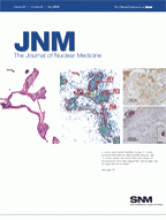TO THE EDITOR: Therapeutic doses of cold fluorothymidine (FLT) used as antiviral therapy have been shown to cause renal, hepatic, and hematologic toxicity within 4 wk of treatment (1). This observed toxicity was of concern when investigational studies using 18F-FLT were initiated in the United States, prompting some investigators applying for a U.S. Food and Drug Administration investigational new drug application to institute eligibility criteria for hematologic (marrow), renal, and hepatic function to avoid any potential “toxicity” from even tracer doses of 18F-FLT. In fact, the current 18F-FLT investigational new drug application held by the Society of Nuclear Medicine contains such criteria. It is noteworthy that restrictive criteria on hepatorenal and hematologic parameters were implemented, although the 18F-FLT nucleoside dose (in μg) given for imaging purposes is at least 10,000 times lower than truly pharmacologic doses given for therapy with cold FLT (i.e., ∼1 μg vs. >20,000 μg given as a single dose, with multiple doses typically given) (1).
Hundreds of doses of 18F-FLT have been administered worldwide (2–12). Although it seems logical that the tracer dose associated with an 18F-FLT imaging study is unlikely to cause hepatorenal or hematologic toxicity, no data pertaining to the presence or lack thereof have been reported to date. On the other hand, the current eligibility criteria requiring normal or near-normal hematologic, renal, and hepatic parameters before 18F-FLT tracer injection done for the sole purpose of avoiding presumed 18F-FLT toxicity is, in our experience, an impediment to accruing patients in protocols aimed at evaluating the potential merits of 18F-FLT as an oncologic imaging agent.
There is an inherent problem in assessing any potential hepatorenal or hematologic toxicity from 18F-FLT imaging doses in patients given 18F-FLT shortly before some form of treatment. Most of these treatments are myelotoxic and, often, have significant hepatorenal toxicity as well. Furthermore, depending on the cancer type, elevations of the measured hematologic or hepatorenal parameters within weeks or months after 18F-FLT injection may be the result of progressive disease even without cytotoxic treatment. All of this makes it difficult to assess whether elevations of certain hematologic and hepatorenal parameters after a dose of 18F-FLT for imaging are indeed related to 18F-FLT toxicity. Some patients, however, receive treatments that are known to be only mildly hepato- or renotoxic, providing the opportunity to address whether tracer 18F-FLT doses cause any significant alteration in hepatorenal parameters. We report herein our experience in measuring these parameters in 28 patients who underwent 18F-FLT imaging followed by treatments known not to cause significant hepatorenal toxicity.
Twenty patients with lymphoma underwent 18F-FLT imaging, soon followed in 17 by chemoimmunotherapy with rituximab, cyclophosphamide, hydroxydaunomycin, vincristine, and prednisone (R-CHOP). Seventeen of these patients underwent measurements of alanine aminotransferase (ALT) or aspartate aminotransferase (AST), total bilirubin, and creatinine at baseline and within 1–4 wk or at 12 wk after 18F-FLT injection, 1 patient underwent ALT/AST and creatinine but not bilirubin measurement at these time points, and 2 underwent only creatinine measurements. The patients were assessed for gradable hepatorenal toxicity as defined by the Common Toxicity Criteria (version 2.0) of the National Cancer Institute.
None of the 20 patients had any renal toxicity. Three of the 18 patients assessable for ALT or AST had transient grade 1 ALT or AST elevation, defined as a value no more than 2.5 times the institutional upper limit of normal, and 1 of 17 patients assessable for total bilirubin had transient grade 1 total bilirubin elevation, defined as a value no more than 1.5 times the institutional upper limit of normal. Only 1 patient had transient grade 2 ALT elevation, defined as a value greater than 2.5 times but no more than 5.0 times the institutional upper limit of normal. All 5 patients with hepatotoxicity received R-CHOP chemotherapy, and this low incidence of hepatotoxicity observed is fully consistent with R-CHOP being mildly hepatotoxic and sometimes causing generally slight, transient elevations of transaminases or bilirubin in patients not receiving any 18F-FLT.
One of 8 patients with head and neck cancers who underwent chemotherapy and radiation soon after 18F-FLT imaging showed a transient grade 1 elevation of creatinine, with none demonstrating gradable hepatic toxicity.
In summary, our experience in a limited number of cancer patients imaged with 18F-FLT followed by treatments known not to cause significant hepatorenal toxicity suggests that such toxicity is unlikely to occur after 18F-FLT tracer doses. Unfortunately, because of the generally myelotoxic nature of most treatments, evaluation of any potential hematologic toxicity after 18F-FLT injection is unreliable. We note, however, that none of the 3 patients with lymphoma who did not receive myelotoxic therapy had any gradable hematologic toxicity. In addition, no gradable white blood cell toxicity was noted in 7 patients with pancreatitis who were imaged with 18F-FLT and were assessable for white blood cell toxicity. We therefore believe that our experience supports eliminating the requirement that baseline hepatorenal and hematologic parameters before 18F-FLT imaging studies be normal or near normal to avoid toxicity from 18F-FLT imaging doses. Such a requirement would, in fact, make it difficult to perform 18F-FLT imaging in, for example, leukemia patients, who often have severely decreased blood cell counts, or in hepatocellular carcinoma or cholangiocarcinoma patients with extensive hepatic lesions, often causing substantial elevation of transaminases or bilirubin (9,11). It is also noteworthy that normal or near-normal baseline hepatic parameters are not required for octreotide imaging of patients with carcinoid tumors, many of whom have numerous hepatic metastases resulting in elevated liver enzymes or hyperbilirubinemia. Obviously, eligibility criteria pertaining to hepatorenal or hematologic parameters are fully justified if administered therapy is likely to cause significant hematologic or hepatorenal toxicity that needs to be monitored, but these eligibility requirements should then be determined by the treating oncologist or the oncologic protocol and not dictated by speculative toxicity from tracer doses of 18F-FLT.
Footnotes
-
COPYRIGHT © 2010 by the Society of Nuclear Medicine, Inc.







